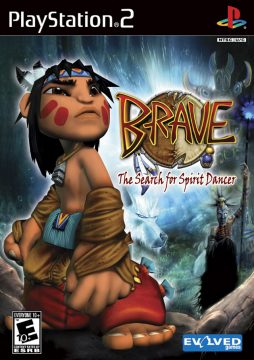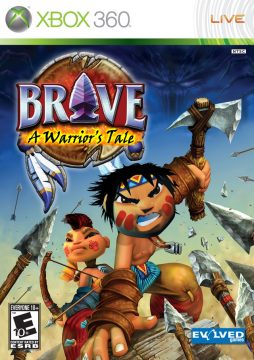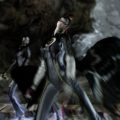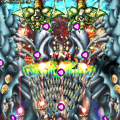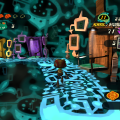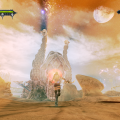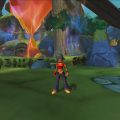During the early days of the PlayStation 2, the 3D platforming genre was bustling, with developers all striving to leave their mark. While some succeeded and birthed franchises, others faded into obscurity. Brave: The Search for Spirit Dancer is one such game - a 2005 hidden gem developed by Vis Entertainment worth playing despite its flaws. Brave: The Search for Spirit Dancer wears its inspirations on its sleeve quite well, drawing from various sources such as Native American mythology and folklore. However, the game doesn’t shy away from introducing several neat ideas here and there.
Originally codenamed Tom-Tom during development, the game’s story puts you in the role of a young Native American named Brave who, after going through a training session (the game’s tutorial), quickly learns that the safety of his tribe is threatened by a malevolent entity known as the Wendigo. While the Wendigo is often portrayed as this menacing, 15-foot-tall walking beast with glowing red eyes in Native American mythology, players may be surprised by the cartoonish depiction of this character in the game.
Brave cannot defeat this entity alone. He’s inexperienced and quite young. Hence, he has to seek help from the legendary Spirit Dancer, believed to be the only one capable of stopping such a destructive force. Brave’s quest to search for the spirit dancer pushes him to explore several locations. The first moments of the game are spent teaching the player the basics: how to move, kick, jump and the art of mimicking animal sounds. (You can also fish albeit it’s a brief experience.) Once players move beyond this introductory phase and delve deeper into the story, events unfold swiftly, marking the true beginning of the game.
While the plot of Brave: The Search for Spirit Dancer is obviously geared towards a younger audience, one can infer that the gameplay follows suit. Brave borrows several inspirations from iconic platformers like Jak & Daxter, but it still introduces some ideas of its own. The problem is that a plethora of these ideas are briefly used throughout the game. Some of them disappear as quickly as you obtain them.
The majority of the game follows the traditional 3D platforming formula. Players guide Brave as he leaps from one platform to another, swings his tomahawk against foes, scales walls, and uncovers vital story items. Brave does have a special charging attack that lets him shatter rocks to clear out paths. While this attack can technically be used against enemies, it is ineffective and unhelpful when faced with multiple adversaries. So, it’s better not to use it. Unless you decide to pair it with the rage mode which can be activated by pressing the R2 button. By employing this combination, you’ll have a powerful advantage above almost anything that comes your way.
The game does eventually equip players with a bow that sticks around for as long as they wish to. Yet, when compared to weapons like the tomahawk, the bow falls short. It inflicts little damage on enemies, especially those capable of guarding themselves. It does help against regular animals like wolves and penguins, but as the player nears the end of the game, the bow is rendered too weak.
Brave: The Search for Spirit Dancer tries not to bore you to sleep, hence players will occasionally find themselves being rewarded with items or power-ups. Nearly every new location has a new thing or two to obtain. Many of these involve blending in with nature by taking control of spiritual animals or using them to gain an edge over enemies Brave can’t fight on his own or certain terrain he can’t normally reach.
These aren’t the only techniques Brave has at his disposal. A few more include shamanistic abilities that revolve around using the elemental powers of lightning or fire on specific enemies. Unfortunately, these impressive shamanistic abilities are only exclusive to specific locations. Once the player is past those sections in the game, they’re put to an eternal rest.
Since the game is aimed mostly toward children, it tries to ensure players are not stuck or unable to find where to go next. This is done through the use of a flashing mobile stone on the bottom left of the screen. It’s used to basically point the player to their next objective, and provide hints lest they find themselves in a predicament and unable to move forward. Luckily, if this tombstone proves to be more of a headache than a helping hand, players can always turn off its presence from the menu.
Brave: The Search of Spirit Dancer is a hidden gem on the PS2, but that doesn’t mean it’s flawless. Several mechanics in the game come and go on a whim, and while maybe the developers have done this so that the game doesn’t fall prey to repetition, it introduces an issue. None of the abilities introduced in Brave are fully explored beyond their intended locations, with some abilities being used only once and tossed immediately. For instance, some abilities like taking hold of a ferociously huge bear spirit could’ve been used more, and probably nobody would have minded seeing that ability being put to work as often. Unfortunately, it didn’t.
There’s the other issue with exploration. Players guide Brave through linear levels where progression involves going from one point to another. Although the levels may appear vast, there’s little incentive to explore the surroundings. Unless you want to collect the secret totems which solely unlock concept art material in the menu.
As a 3D platformer, Brave’s gameplay is fun, with the story doing the heavy lifting for the most part. The controls are quite solid as well. There is a slew of unique and interesting ideas to be explored, but the game doesn’t seem to be able to maintain those ideas for too long. It’s like a toy box where you’re only allowed to have one item at a time.
If only some of the presented ideas were used much more than they were intended, perhaps Brave might have achieved success at the time. And maybe, it could have garnered enough acclaim and sales to warrant a sequel. Intriguingly, a follow-up to Brave was indeed in the works at Vis Entertainment, but unfortunately, the studio closed its doors in 2005 before the project could come to life.
If you love 3D platformers, give Brave: The Search for Spirit Dancer a chance. It may not reach the heights of its brethren from the genre, but it’s still an enjoyable gem to play through during the weekends. Don’t expect a masterpiece, though.
Brave did receive a remastered/HD port release titled Brave: A Warrior’s Tale for the Xbox 360 and the Nintendo Wii in 2009, but it can hardly be called a remaster since the changes are pretty minimal. There were other plans to port Brave into the PSP, but that version of the game was never released due to some unknown complications.
Links

